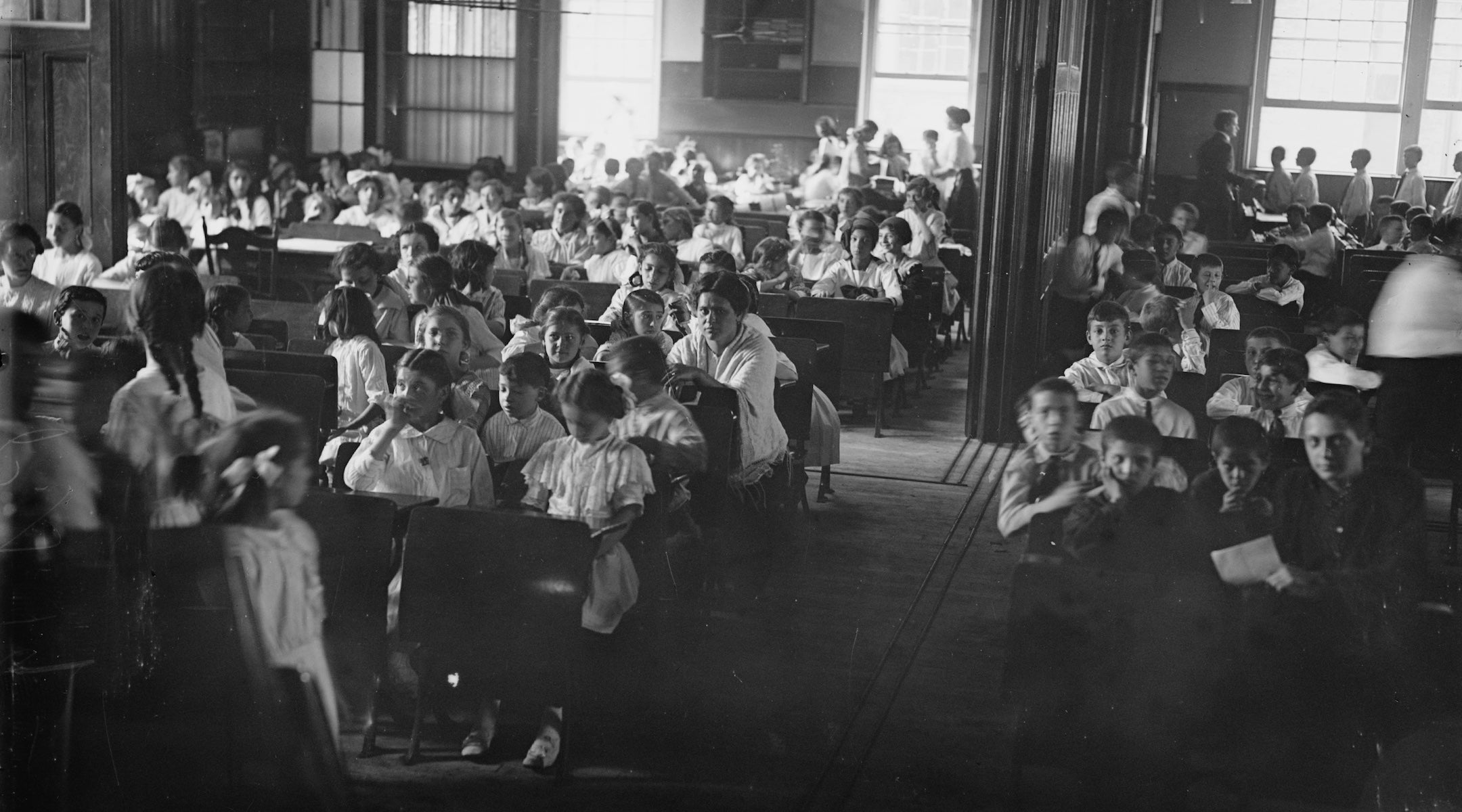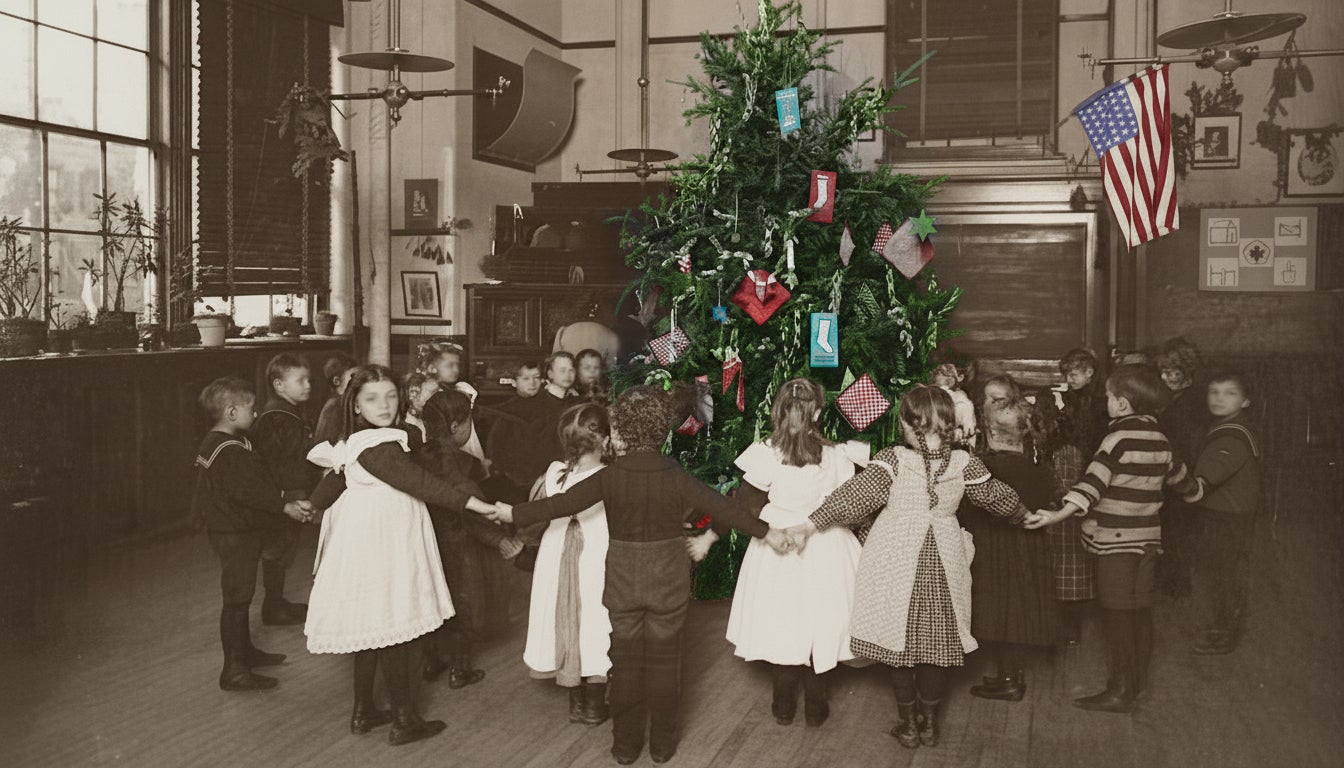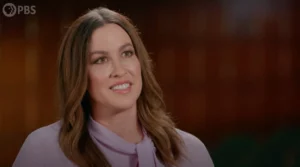On a frigid winter’s day in 1906, tens of thousands of Jewish parents in New York’s Lower East Side and Brooklyn kept their children home from school.
It wasn’t a snow day, but a protest: Activists and the Yiddish press had called for a boycott of the Christmas assemblies and pageants that they knew Jewish children would be obliged to attend on the day before the holiday.
“Jews Object to Christmas in the Schools,” blared the New York Times. The Brooklyn Eagle warned that “agitators” sought to rob Christian children of their traditions. The boycott was, depending on the source, a valiant cry for religious freedom, or the first shot in the 100-year-plus “war on Christmas.”
The episode is the subject of historian Scott D. Seligman’s new book, “The Great Christmas Boycott of 1906,” which reconstructs how a seemingly local dispute in one Brooklyn school exploded into a test case for religious freedom and civic belonging.
More than a century later, Seligman suggests, the issues it raised — over religion in public schools and the boundaries of church and state — remain strikingly familiar.
“As soon as I stumbled on the story, I knew there’d be a book,” said Seligman, who grew up in Newark, New Jersey, in the 1960s, when schoolchildren were still made to recite the Lord’s Prayer. “I was that kid in public school who always wondered why we were praying like Christians, and even why Christmas was a legal holiday.”
In “The Great Christmas Boycott of 1906,” Scott D. Seligman reconstructs how a seemingly local dispute in one Brooklyn school exploded into a test case for religious freedom and civic belonging. (Nebraska University Press)
The book is the third installment in what’s become a trilogy about Jews engaged in mass action during the first part of the 20th century. “The Great Kosher Meat War of 1902” (2020) recalled a successful consumer uprising led by Lower East Side Jewish women fed up with the high cost of beef. In “The Chief Rabbi’s Funeral” (2024), Seligman explored how a vicious anti-Jewish riot on the Lower East Side led the city’s fractious Jewish community to organize as never before.
In practical terms, the Christmas boycott accomplished little, and even led to an antisemitic backlash. But it set a precedent for Jewish civic activism — and for a broader national debate about religion in public education that would stretch into the 21st century.
The spark came a year earlier, in December 1905, at Public School 174 in Brownsville. The Brooklyn neighborhood was a dense warren of immigrant Jews, many newly arrived from Eastern Europe, who eagerly sent their children to the public schools that were being filled nearly as fast as they could be built or renovated.
“The Catholics gave up on the public schools as irredeemably Protestant. The Jews loved public schools — they were a ticket to acculturation and advancement in a way they’d never had in the old country,” said Seligman. “All they wanted was to get the religious influence out.”
In a school assembly the day before Christmas, F. F. Harding, the school’s Presbyterian principal, read aloud from a text called “Gems of Wisdom from Bible Literature and Proverbs” and then addressed his 500 pupils, nearly all Jews.
“Now, boys and girls,” he said, “at this time of year I want you all to have the feeling of Christ in you. … Be like Christ.”
That message did not sit well with Augusta (“Gussie”) Herbert, a 14-year-old seventh grader. The daughter of a Jewish lawyer, Herbert stood up in front of the assembled students and asked why the Christian religion was being taught in a public school.
Her boldness shocked classmates and administrators alike. But she wasn’t alone. Dozens of Jewish children went home and told their parents that Christmas hymns and Bible readings had been part of their school day. Within days, Brownsville’s Jewish community was in an uproar.
Herbert’s father, Edward Herbert, brought the matter to Albert Lucas, a 47-year-old English-born activist who served as secretary of the Union of Orthodox Jewish Congregations of America.
Lucas, born Abraham Abrahamson in Liverpool, was already a veteran of Jewish communal battles. He had led campaigns against Christian “settlement houses” that sought to convert Jewish children with free meals and holiday gifts. To him, the creeping Christianization of public schools was a subtler but equally serious threat.
“Lucas believed the schools were the front line in preserving Jewish identity in America,” Seligman said. “He saw it as his duty to protect children from being made to feel like second-class citizens.”
Lucas wrote to the city’s superintendent of schools, William Henry Maxwell, who had already issued a circular in 1903 reminding principals that “hymns containing reference to the tenets of any religious sect are out of place in unsectarian schools.” But enforcement was lax, and many teachers — Jewish and Christian alike — ignored the rule.
When word of Harding’s assembly reached Lucas, he pounced. Within two days, a petition circulated in Brownsville accusing the principal of “systematically Christianizing” Jewish children. The Hebrew Standard and Jewish Comment denounced the “proselytizing” in public schools, while the Brooklyn Eagle, the borough’s popular daily, defended the principal as merely promoting “good morals.”
In an unprecedented move, the Board of Education held a public hearing to weigh charges that a school principal had promoted religion. It drew a raucous crowd of 1,500.
The hearing revealed sharp divisions even within the Jewish community. Some defended Harding as a well-meaning educator; others accused him of deliberately blurring the line between civic virtue and Christian faith. In the end, the board gave Harding a slap on the wrist, in what Seligman calls “an early Easter gift.”
For Lucas and the Orthodox Union, the Harding verdict only confirmed that quiet lobbying wasn’t enough. They began to organize Jewish parents directly.
Their campaign reflected the broader social tensions of the time. Progressive reformers such as Superintendent Maxwell believed that public schools were engines of “Americanization,” meant to instill not only English and arithmetic but also civic and moral values. For many teachers, “being a good American” was synonymous with “being a good Christian.”
At the same time, America’s Jews were divided along class and ethnic lines. Uptown, German-born Jews — who had arrived decades earlier — feared that the noisy protests of their Yiddish-speaking coreligionists would jeopardize their own fragile acceptance. Downtown, newer immigrants saw those elites as assimilationist and out of touch.
By December 1906, with no change in policy, the Orthodox Union and the Yiddish press decided to act. Two newspapers — the Morgen Zhurnal and the Yidishes Tageblatt — called on Jewish parents to keep their children home on Dec. 24, when schools would hold Christmas exercises.
By most accounts, the response was overwhelming. In the Lower East Side and Brownsville, entire classrooms emptied out. Contemporary estimates suggested that between one third and twothirds of Jewish students were absent from heavily Jewish districts — perhaps 20,000 to 25,000 children citywide.
Anti-Jewish letters to the editor poured in, accusing the protesters of trying to “Judaize” the schools and “destroy” America’s Christian heritage. Protestant ministers accused Jews of ingratitude. Editorials described them as “latecomers, tolerated guests in a Christian country.”
Not all Jews supported the boycott. Abraham Stern, a German-Jewish member of the Board of Education, called the protesters “agitators” and said their actions lacked “the support of the more intelligent Jews of the city.”
Julia Richman, the city’s first female district superintendent — herself a Jewish reformer — said Christmas was both “religious and national” and should not be barred from schools “so long as it is not sectarian.”
Even some Reform rabbis dissented, including Judah L. Magnes of Temple Emanu-El, who favored cultural coexistence over confrontation.

An assembly at a New York City school, ca. 1910. (Bain Collection/Library of Congress)
But among the Yiddish-speaking press, the boycott was a point of pride. “Never before,” wrote one editor, “have Jewish workers stood up so boldly for their rights as Americans.”
Lucas and the boycotters were able to point to the New York State Constitution, which explicitly prohibited the use of public funds for schools teaching “the tenets of any religious sect” — a legacy of the long conflict between a Protestant establishment and Catholics.
But if law was on the side of the Jews, Seligman said, “the politics was not.” The Board of Education, caught between outraged Christians and emboldened Jews, eventually let the matter drop.
“At the end of the day, if you’re pushing for minority rights, you’re not going to get a lot of help from elected officials. Your best bet is always going to be the courts,” said Seligman.
By 1907, with no appetite for another boycott, the Orthodox Union’s activism around the issue waned. Hymns with religious themes were discouraged but not banned. Trees and wreaths returned to classrooms.
“The hot potato,” Seligman said, “remained in the laps of the school principals.”
It would take until the 1960s, with the Supreme Court’s Engel v. Vitale decision, for school-sponsored prayer to be declared unconstitutional. Even then, Seligman notes, “Christmas programs persisted, largely unchallenged.”
Seligman ends his book by drawing a line from 1906 to today. America’s Jewish population, he notes, is more assimilated and less religious than it was in Lucas’s day. But even as the number of self-identified Christians has been shrinking, Christian nationalists are louder and more politically powerful. And the Supreme Court, increasingly sympathetic to religious expression, has eroded some of the wall between church and state that figures like Lucas fought to preserve.
Jews, writes Selgiman, “are ostensibly in more or less the same position in which the New York Board of Education left them in 1907: forced to accept celebrations of a holiday in which they do not believe in the public schools attended by their children, paid for in part by their tax dollars.”
For Seligman, the lesson of 1906 is less about Christmas than about vigilance. The false accusation of a “Jewish war on Christmas,” he writes, “is as inevitable today as it was in 1906 — if not more so.”
And Gussie Herbert’s defiant question — “Why are you teaching the Christian religion in a public school?” — still echoes, more than a century later, whenever Americans debate where faith ends and the public square begins.
Power the news that matters to you. Before 2025 ends, help (JR)’s independent, award-winning newsroom document Jewish history in real-time.




